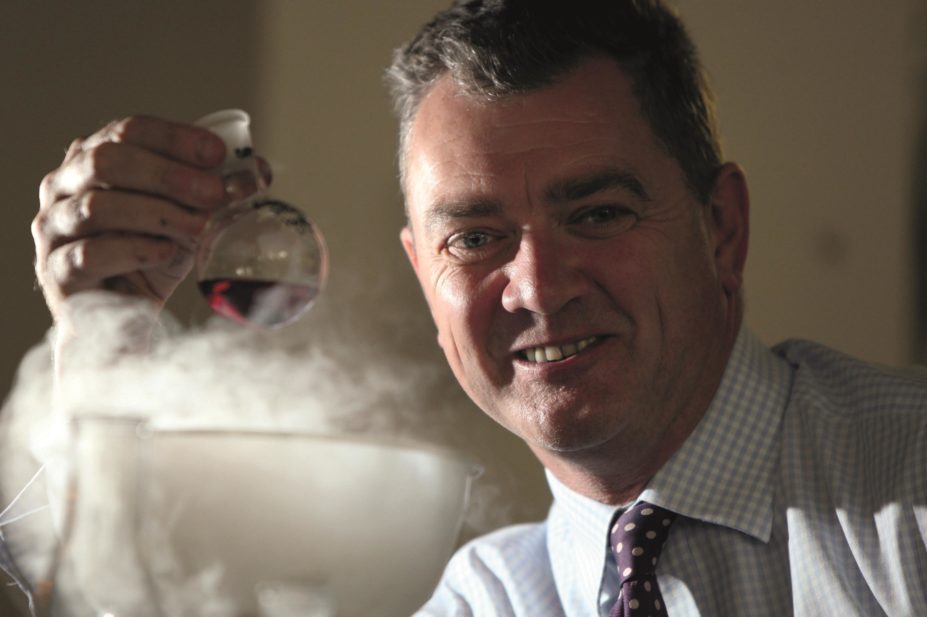
Chris McGuigan, professor of medicinal chemistry at Cardiff University’s School of Pharmacy and Pharmaceutical Sciences, specialises in drug discovery and development for cancer, HIV, hepatitis B and C, shingles, osteoarthritis, measles and influenza. He is also chairman of Life Sciences Hub Wales, which aims to support world-class science in Wales and develop new therapeutic treatments in areas of unmet medical and veterinary needs.
What is the Life Sciences Hub Wales and why is it needed?
The Life Sciences Hub Wales has been set up to enable health and life sciences to boost the economy in Wales. It is a physical space to bring together all the players needed to make the life science business in Wales a success. Since its opening in July 2014, 64 organisations have joined, including the four leading universities in Wales [Cardiff, Swansea, Bangor and Aberystwyth], the NHS, the government, financial and professional services, and businesses from household names, such as Microsoft and Johnson & Johnson, to small start-up device and diagnostics firms.
Our main performance indicator is money and jobs. Over the next eight years, we want to add £1bn to the value of life science companies in Wales.
Aberystwyth, Bangor, Cardiff and Swansea Universities each have a permanent desk at the hub, and Cardiff Metropolitan University and the University of South Wales are also members so any company coming to Wales can see representatives of all of them in a single place. In addition, there are regulatory, patent, legal and accountancy advisers available on a regular basis to offer free initial consultations to research scientists, clinicians and businesses.
How do its aims fit with other UK government initiatives to boost pharmaceutical research?
For a long time, pharmaceutical research funding focused on the “golden triangle” of London, Oxford and Cambridge, but I can say that the recent commitment of the Welsh government has been astonishingly good. As well as money for the hub, Edwina Hart, the Welsh Minister for Economy, Science and Transport, has committed £50m for the Wales Life Sciences Investment Fund and Mark Drakeford, Minister for Health and Social Services, has committed £7.5m for the Life Sciences Research Network Wales, and the pharmaceutical sector has a strong voice in all of this.
The fund, which has to match the £50m investment from the Welsh government, will support promising existing companies and new start-ups, attract non-Welsh companies, entrepreneurs and corporate venture spin-outs to Wales, and encourage and back international partnerships. In its first year, the fund reviewed over 300 business plans and funded five, investing a total of £18m. Alongside this, the fund attracted £40m of investment, including world-class, blue-chip investors that have never invested before in Wales.
To be successful, proposed research must be based on good science, address an unmet medical need and demonstrate a potential route to market.
Do universities reap as much financial benefit as they should from their pharmaceutical discoveries?
Historically, they probably haven’t but across the UK they are getting better. British academics tended to regard the end of the road as the Nature paper about their discovery. Now, as part of the Research Excellence Framework for university assessment, academics must demonstrate the impact of their research and, in our sector, there’s no better impact than getting a drug into patients. As a result, researchers are prepared to delay publication in order to ensure protection of their intellectual property. In my lab, licensing of our discovery of what was, at the time, the most potent polymerase inhibitor for hepatitis C — INX189 — brought about US$1m of investment to the lab, supporting four full-time researchers for several years. Companies licensing compounds like ours also bring overhead money into universities to support core infrastructure. There are milestone cash payments – pre-clinical and clinical and, for the lucky few, a royalty for a product that gets to market.
Which of your drug discoveries are you most proud of?
I am most proud of the generic technology called ProTides — pro-drugs of nucleotides — which I invented back in 1996. ProTides are masked phosphates and they were the world’s first robust technology for delivering charged phosphates into cells. It sounds very erudite but it turns out that half of antivirals, including aciclovir and AZT, and a quarter of anti-cancer agents, such as gemcitabine, are only active in cells if they are in their phosphate form. Having developed ProTides to get nucleosides into cells as phosphates, we worked with GlaxoSmithKline on ProTides in HIV and with Roche on ProTides for hepatitis B and hepatitis C.
We then made our own ProTide compound for hepatitis C, which was licensed to Inhibitex, as INX 189, and went from first synthesis in Cardiff to first dosing of a volunteer in just 18 months. BMS bought Inhibitex for US$2.5bn in January 2012, and INX 189 showed efficacy in pre-clinical, phase I and II studies. But tragically, when INX189 was combined with another experimental agent in a further clinical trial, there was a death from cardiotoxicity and the trial was closed. We don’t know if it was one of the drugs or an interaction.
A version of ProTide technology is used in Gilead’s hepatitis C drug, sofosbuvir, which became the world’s fastest selling drug ever. It’s not my drug, but it’s based on my technology and I’m proud to have invented the core technology.
There has been debate about the cost of medicines to treat hepatitis C. Do you think they are priced excessively?
Sofosbuvir is certainly aggressively priced. Hepatitis C is difficult to treat and the natural outcome of the disease in many cases is a liver transplant, which is expensive in itself and impractical for all 180 million people worldwide with the disease. Previous therapy with pegylated interferon and ribavirin didn’t work in all the serotypes, side effects were a problem and compliance was rather low. Protease inhibitors weren’t a panacea, so people looked for polymerase inhibitors. Sofosbuvir was the first and it’s a good drug – well tolerated and curative in many cases. Gilead did pay US$11bn for Pharmasset to get this one drug and it’s fair to think they should be compensated for bringing such an innovative drug through.
Is it fairly priced? That’s beyond my pay grade, but hopefully Gilead will follow the lead of other pharmaceutical companies with HIV drugs in reducing prices in poorer countries. In any case it’s vital that pharmaceutical innovation is adequately rewarded.
What is currently your main therapeutic area of research?
In oncology, we have applied our ProTide technology to improve response to blockbuster drug gemcitabine. Currently, a patient’s response to the drug depends on whether they have a transporter to get gemcitabine into cells and a kinase to add a phosphate to the compound, as well as absence of the enzyme that deactivates gemcitabine through deamination.
In our new agent, called Acelarin, we’ve attached a ProTide to gemcitabine in order to bypass all three of these mechanisms. An early phase, dose-finding study, sponsored by NuCana BioMed, was completed in 70 terminal cancer patients with solid tumours unresponsive to other therapies. We saw an approximately 80% response of some kind — tumour shrinkage or stabilisation — and one patient is still alive after 18 months and remains on compassionate use therapy. We are now opening registration trials of Acelarin in four types of cancer that responded well, and the first of these trials has just started in ovarian cancer. The others will be in pancreatic, biliary and lung cancers, and all will be sufficiently powered to show efficacy. As of today, it’s probably my single most exciting achievement.
How can we encourage more research into neglected diseases when there is little return on investment?
Various tax and other incentives have attempted to tackle this but it’s not surprising that companies aren’t prepared to risk a potential US$1.2bn to develop a drug if it’s only going to be used by 100 people. Some possible answers focus around taking some of the risk out of researching drugs. That could mean funding pre-clinical research out of the public purse and forming public-private partnerships to drive programmes forward — such as those we are fostering through the hub and the National Research Network. But the big expense comes when clinical trials start, so there may need to be new, innovative pricing structures for new products so that companies would be rewarded not by volume of sales but by clinical need.
What exciting advances in drug discovery can we hope for in the next few years?
The one area that has largely evaded pharma is neurological illness and dementia, and here at Cardiff we have a brand new programme in multiple sclerosis applying our ProTide technologies, which we hope will be fruitful. I’m also optimistic that, over the next ten years, we will see the new research structures that we are putting in place making a real impact on poorly treated diseases such as dementia.

